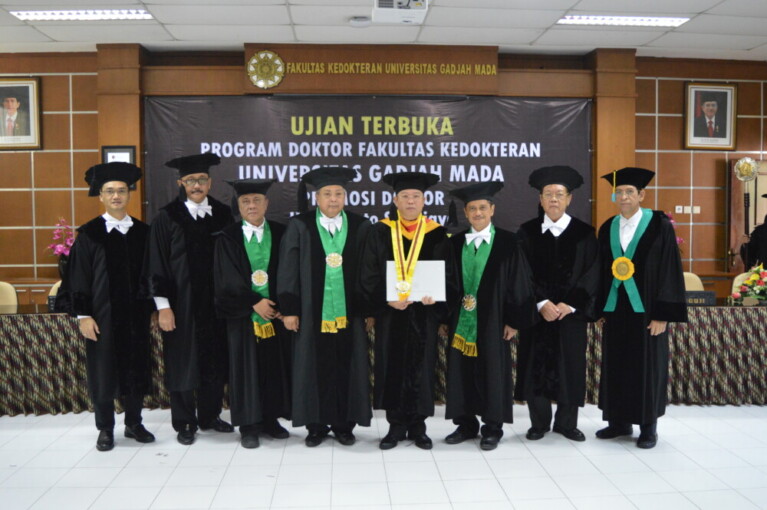
In neurosurgery field, there have been many treatments of meningioma tumor which has progesterone receptor and it is often associated with hyperostosis in calvaria bone as a proof of progesterone receptor role in making the bone matrix, thus causing hyperostosis in the calvaria bone. However, there is no research regarding the correlation between hyperostosis in meningioma with the existence of progesterone receptor in the tumor.
“Based on the literature, meningioma with hyperostosis had been known since thousand years ago but its causative factor has yet to be known until these recent days. Therefore, I am interested in researching the role of the progesterone receptor in the formation of calvaria bone hyperostosis in meningioma tumor,” said Handrianto Setiajaya during an open examination for the Doctoral program on Wednesday (12/4) at Faculty of Medicine UGM.
Meningioma is an intracranial benign tumor which is often found with the number of incidents varies depending on the research in each country with the average of 0.61-2.42% cases per 100,000 people. Handrianto said it is known from research that the number of women who suffer this tumor is more than the men. It is caused by the influence of sex hormone which has a significant role in determining the characteristics of intracranial meningioma.
“This is strengthened by several case reports which stated that meningioma tumor gets bigger quickly and becomes symptomatic during hormonal fluctuation, particularly during pregnancy and luteal phase of menstruation cycle. The progesterone level is increasing during those periods which can stimulate the growth of meningioma tumor,” he explained.
In his dissertation entitled the Relation between Progesterone Receptor with the Formation of Calvaria Hyperostosis in Meningioma, Handrianto reveals the mechanism of hyperostosis formation in meningioma caused by the activation of osteoblast through the role of the progesterone receptor in calvaria around the tumor.
Using several methods, his research produces a result which is opposite from the hypothesis which states that the expressive increment of the progesterone receptor is often found in meningioma with hyperostosis more than the non-hyperostosis one, the hyperostosis in calvaria is also found in the increment of osteoblast cell more than the non-hyperostosis bone.
“Based on the result and discussion, it is concluded that there is no significant correlation between meningioma with a high expression of the progesterone receptor with the emergence of hyperostosis in calvaria,” he added.
In addition, he also found the weak negative correlation between the high expression intensity of progesterone receptor with the thickness of osteoid matrix as a representation of osteoblast activity in calvaria as well as the correlation between age factor and hyperostosis.
However, he admitted his research still has a weakness because it was only conducted in a research center in which the variation of its patients was not enough to generalize the result of a bigger population. Therefore, according to him, it needs an advanced research by adding the variables and the number of samples as well as using multicenter research in order to represent a bigger population and it is expected to make an alteration of correlation between the intensity of progesterone receptor and hyperostosis.


